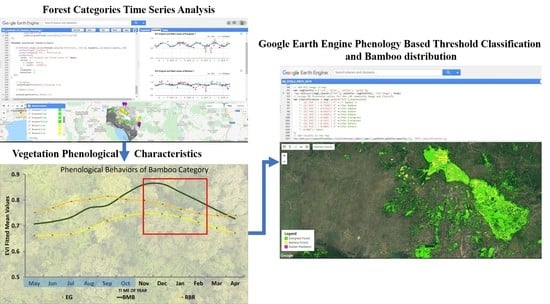Mapping the Natural Distribution of Bamboo and Related Carbon Stocks in the Tropics Using Google Earth Engine, Phenological Behavior, Landsat 8, and Sentinel-2
Abstract
1. Introduction
2. Study Materials and Methods
2.1. Study Area
2.2. Remote Sensing Data
2.3. Methodology
- Imagery preprocessing and time-series collections were filtered for the dry mid-phenology season (from December to February).
- Image filter functions were applied to select image collections in the particular phenological period within the study region [13].
- The PBTC function was applied to the bamboo forest, evergreen forest, and rubber plantation categories.
2.4. Accuracy Assessment
2.5. Bamboo Carbon Stock Assessment
3. Results
3.1. Phenological Profiles and Threshold Values
3.2. Natural Distribution of Bamboo Forest
3.3. Accuracy Assessment
3.4. Area of Bamboo Forest and Its Carbon Stocks by Districts
4. Discussion
5. Conclusions
Author Contributions
Funding
Acknowledgments
Conflicts of Interest
Appendix A
| Landsat 8 OLI EVI function |
| // Add an EVI function for the Landsat 8 TAO collections. |
| function addEVI(Landsat8){ |
| return Landsat8.addBands(Landsat8.expression) |
| ‘2.5 * ((NIR - RED) / (NIR + 6 * RED - 7.5 * BLUE + 1))’, |
| { |
| ‘NIR’: Landsat8.select(‘B5’), |
| ‘RED’: Landsat8.select(‘B4’), |
| ‘BLUE’: Landsat8.select(‘B2’) |
| }).rename(‘L8EVI’)).float(); |
| }; |
| Sentinel-2 EVI function |
| // Add an EVI function for the Sentinel-2 (SNL) collections. |
| function addEVI(SNL){ |
| return SNL.addBands(SNL.expression( |
| ‘2.5 * ((NIR - RED) / (NIR + 6 * RED - 7.5 * BLUE + 1))’, |
| { |
| ‘NIR’: SNL.select(‘B8’), |
| ‘RED’: SNL.select(‘B4’), |
| ‘BLUE’: SNL.select(‘B2’) |
| }).rename(‘SNLEVI’)).float(); |
| }; |
| where L = 1 (canopy background adjustment factor) [49,50]; C1 = 6 and C2 = 7.5 (aerosol correction factors) and G = 2.5 (gain factor) [49,50,51]; and NIR (Landsat band 5 and Sentinel-2 band 8 (B8), RED (band 4 (B4) in both Landsat and Sentinel-2), and BLUE (band 2 (B2) in both Landsat and Sentinel-2) are atmospherically corrected for surface reflectance in near-infrared, red, and blue bands of Sentinel-2 imagery in GEE [50]. |
References
- Zhou, G.; Meng, C.; Jiang, P.; Xu, Q. Review of Carbon Fixation in Bamboo Forests in China. Bot. Rev. 2011, 77, 262–270. [Google Scholar] [CrossRef]
- Houdanon, R.D.; Mensah, S.; Gnanglè, C.; Yorou, N.S.; Houinato, M. Ecosystem services and biomass stock from bamboo stands in central and southern Benin, West Africa. Energy Ecol. Environ. 2018, 3, 185–194. [Google Scholar] [CrossRef]
- INBAR Bamboo: A strategic resource for countries to reduce the effects of climate change. Policy Synth. Rep. 2014, 1–28.
- Ben-zhi, Z.; Mao-yi, F.; Jin-zhong, X.; Xiao-sheng, Y.; Zheng-cai, L. Ecological functions of bamboo forest: Research and Application. J. For. Res. 2005, 16, 143–147. [Google Scholar] [CrossRef]
- Yuen, J.Q.; Fung, T.; Ziegler, A.D. Carbon stocks in bamboo ecosystems worldwide: Estimates and uncertainties. For. Ecol. Manage. 2017, 393, 113–138. [Google Scholar] [CrossRef]
- Yiping, L.; Yanxia, L.; Buckingham, K.; Henley, G.; Guomo, Z. Bamboo and Climate Change Mitigation: A Comparative Analysis of Carbon Sequestration; International Network for Bamboo and Rattan (INBAR): Beijing, China, 2010; Volume 32, ISBN 978-92-95098-89-3. [Google Scholar]
- Goswami, J.; Tajo, L.; Sarma, K.K. Bamboo resources mapping using satellite technology. Curr. Sci. 2010, 99, 650–653. [Google Scholar]
- Simonetti, D.; Simonetti, E.; Szantoi, Z.; Lupi, A.; Eva, H.D. First Results from the Phenology-Based Synthesis Classifier Using Landsat 8 Imagery. IEEE Geosci. Remote Sens. Lett. 2015, 12, 1496–1500. [Google Scholar] [CrossRef]
- Kou, W.; Xiao, X.; Dong, J.; Gan, S.; Zhai, D.; Zhang, G.; Qin, Y.; Li, L. Mapping deciduous rubber plantation areas and stand ages with PALSAR and landsat images. Remote Sens. 2015, 7, 1048–1073. [Google Scholar] [CrossRef]
- Dong, J.; Xiao, X.; Menarguez, M.A.; Zhang, G.; Qin, Y.; Thau, D.; Biradar, C.; Moore, B. Mapping paddy rice planting area in northeastern Asia with Landsat 8 images, phenology-based algorithm and Google Earth Engine. Remote Sens. Environ. 2016, 185, 142–154. [Google Scholar] [CrossRef]
- Fan, H.; Fu, X.; Zhang, Z.; Wu, Q.; Fan, H.; Fu, X.; Zhang, Z.; Wu, Q. Phenology-Based Vegetation Index Differencing for Mapping of Rubber Plantations Using Landsat OLI Data. Remote Sens. 2015, 7, 6041–6058. [Google Scholar] [CrossRef]
- Zhang, M.; Gong, P.; Qi, S.; Liu, C.; Xiong, T. Mapping bamboo with regional phenological characteristics derived from dense Landsat time series using Google Earth Engine. Int. J. Remote Sens. 2019, 40, 9541–9555. [Google Scholar] [CrossRef]
- Venkatappa, M.; Sasaki, N.; Shrestha, R.P.; Tripathi, N.K.; Ma, H.O. Determination of vegetation thresholds for assessing land use and land use changes in Cambodia using the Google Earth Engine cloud-computing platform. Remote Sens. 2019, 11, 1514. [Google Scholar] [CrossRef]
- Alwashe, M.A.; Bokhari, A.Y. Monitoring vegetation changes in Al Madinah, Saudi Arabia, using Thematic Mapper data. Int. J. Remote Sens. 1993, 14, 191–197. [Google Scholar] [CrossRef]
- Tsai, Y.H.; Stow, D.; Chen, H.L.; Lewison, R.; An, L.; Shi, L. Mapping vegetation and land use types in Fanjingshan National Nature Reserve using google earth engine. Remote Sens. 2018, 10, 927. [Google Scholar] [CrossRef]
- Xiao, C.; Li, P.; Feng, Z.; Liu, X. An updated delineation of stand ages of deciduous rubber plantations during 1987-2018 using Landsat-derived bi-temporal thresholds method in an anti-chronological strategy. Int. J. Appl. Earth Obs. Geoinf. 2019, 76, 40–50. [Google Scholar] [CrossRef]
- Wang, J.; Xiao, X.; Qin, Y.; Dong, J.; Zhang, G.; Kou, W.; Jin, C.; Zhou, Y.; Zhang, Y. Mapping paddy rice planting area in wheat-rice double-cropped areas through integration of Landsat-8 OLI, MODIS, and PALSAR images. Sci. Rep. 2015, 5. [Google Scholar] [CrossRef] [PubMed]
- Schwieder, M.; Leitão, P.J.; Pinto, J.R.R.; Teixeira, A.M.C.; Pedroni, F.; Sanchez, M.; Bustamante, M.M.; Hostert, P. Landsat phenological metrics and their relation to aboveground carbon in the Brazilian Savanna. Carbon Balance Manag. 2018, 13, 7. [Google Scholar] [CrossRef]
- Fava, F.; Colombo, R. Remote sensing-based assessment of the 2005-2011 bamboo reproductive event in the arakan mountain range and its relation with wildfires. Remote Sens. 2017, 9, 85. [Google Scholar] [CrossRef]
- Nath, A.J.; Das, G.; Das, A.K. Vegetative phenology of three bamboo species in subtropical humid climate of Assam. Trop. Ecol. 2008, 49, 85–89. [Google Scholar]
- Tang, Y.; Jing, L.; Li, H.; Liu, Q.; Yan, Q.; Li, X. Bamboo classification using worldview-2 imagery of giant panda habitat in a large shaded area in wolong, Sichuan province, China. Sensors 2016, 16, 1957. [Google Scholar] [CrossRef]
- Adole, T.; Dash, J.; Atkinson, P.M. Characterising the land surface phenology of Africa using 500 m MODIS EVI. Appl. Geogr. 2018, 90, 187–199. [Google Scholar] [CrossRef]
- Verhegghen, A.; Bontemps, S.; Defourny, P. A global NDVI and EVI reference data set for land-surface phenology using 13 years of daily SPOT-VEGETATION observations. Int. J. Remote Sens. 2014, 35, 2440–2471. [Google Scholar] [CrossRef]
- Matsushita, B.; Yang, W.; Chen, J.; Onda, Y.; Qiu, G. Sensitivity of the Enhanced Vegetation Index (EVI) and Normalized Difference Vegetation Index (NDVI) to Topographic Effects: A Case Study in High-density Cypress Forest. Sensors 2007, 7, 2636–2651. [Google Scholar] [CrossRef] [PubMed]
- Gurung, R.B.; Breidt, F.J.; Dutin, A.; Ogle, S.M. Predicting Enhanced Vegetation Index (EVI) curves for ecosystem modeling applications. Remote Sens. Environ. 2009, 113, 2186–2193. [Google Scholar] [CrossRef]
- Kou, W.; Liang, C.; Wei, L.; Hernandez, A.; Yang, X. Phenology-Based Method for Mapping Tropical Evergreen Forests by Integrating of MODIS and Landsat Imagery. Forests 2017, 8, 34. [Google Scholar] [CrossRef]
- Mishra, N.B.; Crews, K.A.; Neuenschwander, A.L. Sensitivity of EVI-based harmonic regression to temporal resolution in the lower Okavango Delta. Int. J. Remote Sens. 2012, 33, 7703–7726. [Google Scholar] [CrossRef]
- Chen, Y.; Li, L.; Lu, D.; Li, D. Exploring bamboo forest aboveground biomass estimation using Sentinel-2 data. Remote Sens. 2019, 11, 7. [Google Scholar] [CrossRef]
- SijiMol, K.; Dev, S.A.; Sreekumar, V.B. A Review of the Ecological Functions of Reed Bamboo, Genus Ochlandra in the Western Ghats of India: Implications for Sustainable Conservation. Trop. Conserv. Sci. 2016, 9, 389–407. [Google Scholar] [CrossRef]
- Sasaki, N.; Chheng, K.; Mizoue, N.; Abe, I.; Lowe, A.J. Forest reference emission level and carbon sequestration in Cambodia. Glob. Ecol. Conserv. 2016, 7, 82–96. [Google Scholar] [CrossRef]
- Chheng, K.; Sasaki, N.; Mizoue, N.; Khorn, S.; Kao, D.; Lowe, A. Assessment of carbon stocks of semi-evergreen forests in Cambodia. Glob. Ecol. Conserv. 2016, 5, 34–47. [Google Scholar] [CrossRef]
- Avtar, R.; Suzuki, R.; Takeuchi, W.; Sawada, H. PALSAR 50 m Mosaic Data Based National Level Biomass Estimation in Cambodia for Implementation of REDD+ Mechanism. PLoS ONE 2013, 8, e74807. [Google Scholar] [CrossRef] [PubMed]
- Singh, M.; Evans, D.; Chevance, J.B.; Tan, B.S.; Wiggins, N.; Kong, L.; Sakhoeun, S. Evaluating remote sensing datasets and machine learning algorithms for mapping plantations and successional forests in Phnom Kulen National Park of Cambodia. PeerJ 2019, 2019, e7841. [Google Scholar] [CrossRef]
- Kumar, L.; Mutanga, O. Google Earth Engine Applications Since Inception: Usage, Trends, and Potential. Remote Sens. 2018, 10, 1509. [Google Scholar] [CrossRef]
- Gorelick, N.; Hancher, M.; Dixon, M.; Ilyushchenko, S.; Thau, D.; Moore, R. Google Earth Engine: Planetary-scale geospatial analysis for everyone. Remote Sens. Environ. 2017, 202, 18–27. [Google Scholar] [CrossRef]
- Lopezaraiza-mikel, M.; Quesada, M.; Daniel, L.; Cabadilla, A. Phenological patterns of tropical dry forest along latitudinal and successional gradients in the Neotropics. In Tropical Dry Forests in the Americas: Ecology, Conservation, and Management; Sánchez-Azofeifa, A., Powers, J.S., Fernandes, G.W., Quesada, M., Eds.; CRC Press: Boca Raton, FL, USA, 2014; pp. 101–128. [Google Scholar]
- Huang, H.; Chen, Y.; Clinton, N.; Wang, J.; Wang, X.; Liu, C.; Gong, P.; Yang, J.; Bai, Y.; Zheng, Y.; et al. Mapping major land cover dynamics in Beijing using all Landsat images in Google Earth Engine. Remote Sens. Environ. 2017, 202, 166–176. [Google Scholar] [CrossRef]
- Sidhu, N.; Pebesma, E.; Câmara, G. Using Google Earth Engine to detect land cover change: Singapore as a use case. Eur. J. Remote Sens. 2018, 51, 486–500. [Google Scholar] [CrossRef]
- Markert, K.N.; Schmidt, C.M.; Griffin, R.E.; Flores, A.I.; Poortinga, A.; Saah, D.S.; Muench, R.E.; Clinton, N.E.; Chishtie, F.; Kityuttachai, K.; et al. Historical and operational monitoring of surface sediments in the Lower Mekong Basin using Landsat and Google Earth Engine cloud computing. Remote Sens. 2018, 10, 909. [Google Scholar] [CrossRef]
- Aryal, J.P.; Sapkota, T.B.; Khurana, R.; Khatri-Chhetri, A.; Rahut, D.B.; Jat, M.L. Climate change and agriculture in South Asia: Adaptation options in smallholder production systems. Environ. Dev. Sustain. 2019, 1–31. [Google Scholar] [CrossRef]
- NIS National Institute of Statistics. Available online: http://www.nis.gov.kh/index.php/en/ (accessed on 19 August 2020).
- Rao, A.N.; Ramanatha Rao, V.; Institute, I.P.G.R. Bamboo—Conservation, diversity, ecogeography, germplasm, resources utilization and taxonomy. In Proceedings of the Training Course Cum Workshop, Kunming and Xishuangbanna, Yunnan, China, 10–17 May 1998. [Google Scholar]
- MoE Cambodia Forest Cover 2016. Available online: https://redd.unfccc.int/uploads/54_3_cambodia_forest_cover_resource__2016_english.pdf (accessed on 10 June 2020).
- ODC Open Development Cambodia. Available online: https://opendevelopmentcambodia.net/map-explorer (accessed on 17 August 2020).
- Fawcett, A.D.; Leiterer, R.; Heisig, H.; Wulf, H.; Kellenberger, T.; Joerg, P.C. Google Earth Engine Product Prototypes. 2017. Available online: https://developers.google.com/earth-engine (accessed on 10 June 2020).
- Google Earth Engine Earth Engine Data Catalog. Available online: https://developers.google.com/earth-engine/datasets/ (accessed on 15 August 2020).
- Chander, G.; Markham, B.L.; Helder, D.L. Summary of current radiometric calibration coefficients for Landsat MSS, TM, ETM+, and EO-1 ALI sensors. Remote Sens. Environ. 2009, 113, 893–903. [Google Scholar] [CrossRef]
- Arekhi, M.; Goksel, C.; Sanli, F.B.; Senel, G. Comparative evaluation of the spectral and spatial consistency of Sentinel-2 and Landsat-8 OLI data for Igneada longos forest. ISPRS Int. J. Geo-Inf. 2019, 8, 56. [Google Scholar] [CrossRef]
- Jiang, Z.; Huete, A.R.; Didan, K.; Miura, T. Development of a two-band enhanced vegetation index without a blue band. Remote Sens. Environ. 2008, 112, 3833–3845. [Google Scholar] [CrossRef]
- Banskota, A.; Wynne, R.H.; Johnson, P.; Emessiene, B. Synergistic use of very high-frequency radar and discrete-return lidar for estimating biomass in temperate hardwood and mixed forests. Ann. For. Sci. 2011, 68, 347–356. [Google Scholar] [CrossRef]
- Samreth, V.; Chheng, K.; Monda, Y.; Kiyono, Y.; Toriyama, J.; Saito, S.; Saito, H.; Ito, E. Tree Biomass Carbon Stock Estimation using Permanent Sampling Plot Data in Different Types of Seasonal Forests in Cambodia. Japan Agric. Res. Q. 2012, 46, 187–192. [Google Scholar] [CrossRef][Green Version]
- Wilson, B.T.; Knight, J.F.; McRoberts, R.E. Harmonic regression of Landsat time series for modeling attributes from national forest inventory data. ISPRS J. Photogramm. Remote Sens. 2018, 137, 29–46. [Google Scholar] [CrossRef]
- Xiong, J.; Thenkabail, P.S.; Tilton, J.C.; Gumma, M.K.; Teluguntla, P.; Oliphant, A.; Congalton, R.G.; Yadav, K.; Gorelick, N. Nominal 30-m cropland extent map of continental Africa by integrating pixel-based and object-based algorithms using Sentinel-2 and Landsat-8 data on google earth engine. Remote Sens. 2017, 9, 65. [Google Scholar] [CrossRef]
- Potere, D. Horizontal positional accuracy of google earth’s high-resolution imagery archive. Sensors 2008, 8, 7973–7981. [Google Scholar] [CrossRef]
- Tilahun, A. Accuracy Assessment of Land Use Land Cover Classification using Google Earth. Am. J. Environ. Prot. 2015, 4, 193. [Google Scholar] [CrossRef]
- Ragheb, A.E.; Ragab, A.F. Enhancement of Google Earth Positional Accuracy. Int. J. Eng. Res. Technol. 2015, 4, 627–630. [Google Scholar]
- Mohammed, N.Z.; Ghazi, A.; Mustafa, H.E. Positional accuracy testing of Google Earth. Int. J. Multidiscip. Sci. Eng. 2013, 4, 6–9. [Google Scholar]
- Olofsson, P.; Foody, G.M.; Herold, M.; Stehman, S.V.; Woodcock, C.E.; Wulder, M.A. Good practices for estimating area and assessing accuracy of land change. Remote Sens. Environ. 2014, 148, 42–57. [Google Scholar] [CrossRef]
- Foody, G.M. Harshness in image classification accuracy assessment. Int. J. Remote Sens. 2008, 29, 3137–3158. [Google Scholar] [CrossRef]
- FREL Initial Forest Reference Level for Cambodia under the UNFCCC Framework. Available online: https://redd.unfccc.int/files/cambodia_frl_rcvd17112016.pdf (accessed on 17 November 2018).
- Lu, H.; Liu, G.; Zhao, J.; Jiang, L. Current remote sensing options for monitoring carbon emissions. Int. Conf. Geoinformatics 2013, 2–5. [Google Scholar]
- Angelsen, A. REDD+ as Result-based Aid: General Lessons and Bilateral Agreements of Norway. Rev. Dev. Econ. 2017, 21, 237–264. [Google Scholar] [CrossRef]
- Venkatesh, G.; Gerdesmeier, D.; Primer, A.; Walther, L.M.; Summary, E.; Pierce, K.E.N.; Fernando, E.S.; Gruezo, W.S.; Bantayan, N.C.; Calderon, M.M.; et al. Sustainable Financing for Forest and Landscape Restoration: Opportunities, Challenges, and the Way Forward; FAO and UNCCD: Rome, Italy, 2016; Volume 11, ISBN 9789251072929. [Google Scholar]
- Sasaki, N.; Asner, G.P.; Pan, Y.; Knorr, W.; Durst, P.B.; Ma, H.O.; Abe, I.; Lowe, A.J.; Koh, L.P.; Putz, F.E. Sustainable Management of Tropical Forests Can Reduce Carbon Emissions and Stabilize Timber Production. Front. Environ. Sci. 2016, 4, 50. [Google Scholar] [CrossRef]
- IPCC Task Force on National Greenhouse Gas Inventories. Available online: https://www.ipcc-nggip.iges.or.jp/public/2006gl/vol4.html (accessed on 10 June 2020).
- TC Cambodia Tourism Statistics - Tourist Information Center | Tourism Cambodia. Available online: https://www.tourismcambodia.com/tourist-information/tourist-statistic.htm (accessed on 29 July 2020).
- Lenzen, M.; Sun, Y.Y.; Faturay, F.; Ting, Y.P.; Geschke, A.; Malik, A. The carbon footprint of global tourism. Nat. Clim. Chang. 2018, 8, 522–528. [Google Scholar] [CrossRef]
- Zhang, C.; Sargent, I.; Pan, X.; Li, H.; Gardiner, A.; Hare, J.; Atkinson, P.M. Joint Deep Learning for land cover and land use classification. Remote Sens. Environ. 2019, 221, 173–187. [Google Scholar] [CrossRef]
- Zhang, X.; Han, L.; Han, L.; Zhu, L. How Well Do Deep Learning-Based Methods for Land Cover Classification and Object Detection Perform on High Resolution Remote Sensing Imagery? Remote Sens. 2020, 12, 417. [Google Scholar] [CrossRef]
- Iizuka, K.; Yonehara, T.; Itoh, M. Estimating Tree Height and Diameter at Breast Height (DBH) from Digital Surface Models and Orthophotos Obtained with an Unmanned Aerial System for a Japanese Cypress (Chamaecyparis obtusa) Forest. Remote Sens. 2018, 10, 13. [Google Scholar] [CrossRef]
- McCabe, M.F.; Rodell, M.; Alsdorf, D.E.; Miralles, D.G.; Uijlenhoet, R.; Wagner, W.; Lucieer, A.; Houborg, R.; Verhoest, N.E.C.; Franz, T.E.; et al. The future of Earth observation in hydrology. Hydrol. Earth Syst. Sci. 2017, 21, 3879–3914. [Google Scholar] [CrossRef] [PubMed]
- Langner, A.; Miettinen, J.; Kukkonen, M.; Vancutsem, C.; Simonetti, D.; Vieilledent, G.; Verhegghen, A.; Gallego, J.; Stibig, H.J. Towards operational monitoring of forest canopy disturbance in evergreen rain forests: A test case in continental Southeast Asia. Remote Sens. 2018, 10, 544. [Google Scholar] [CrossRef]
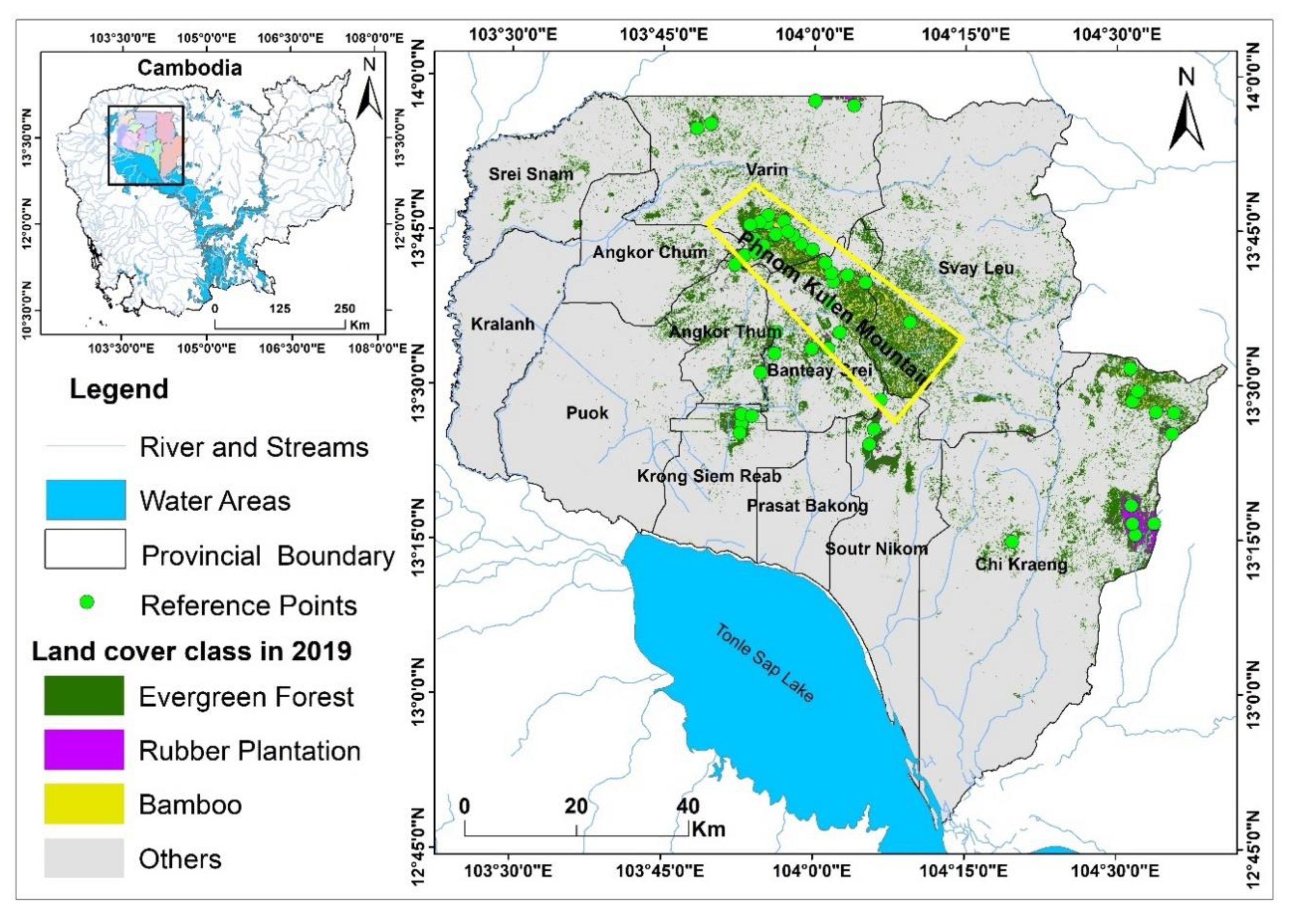
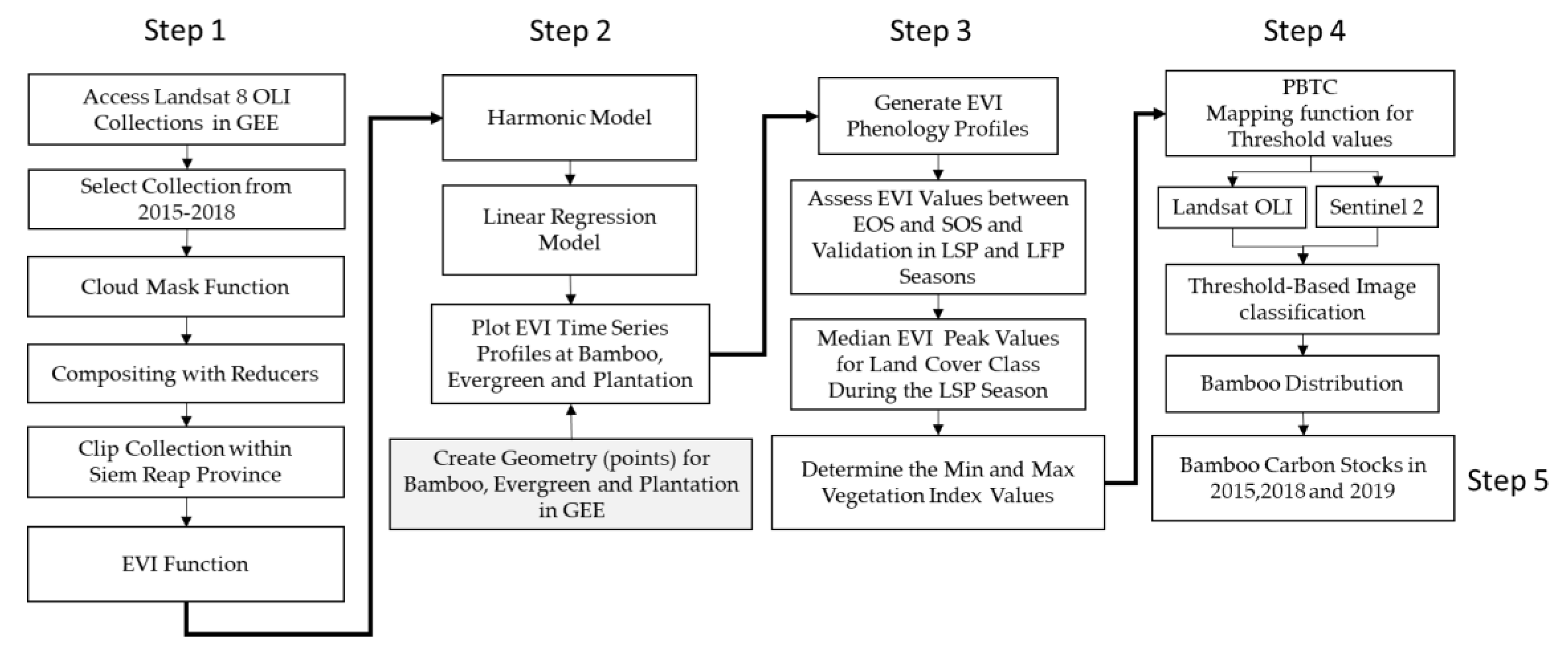
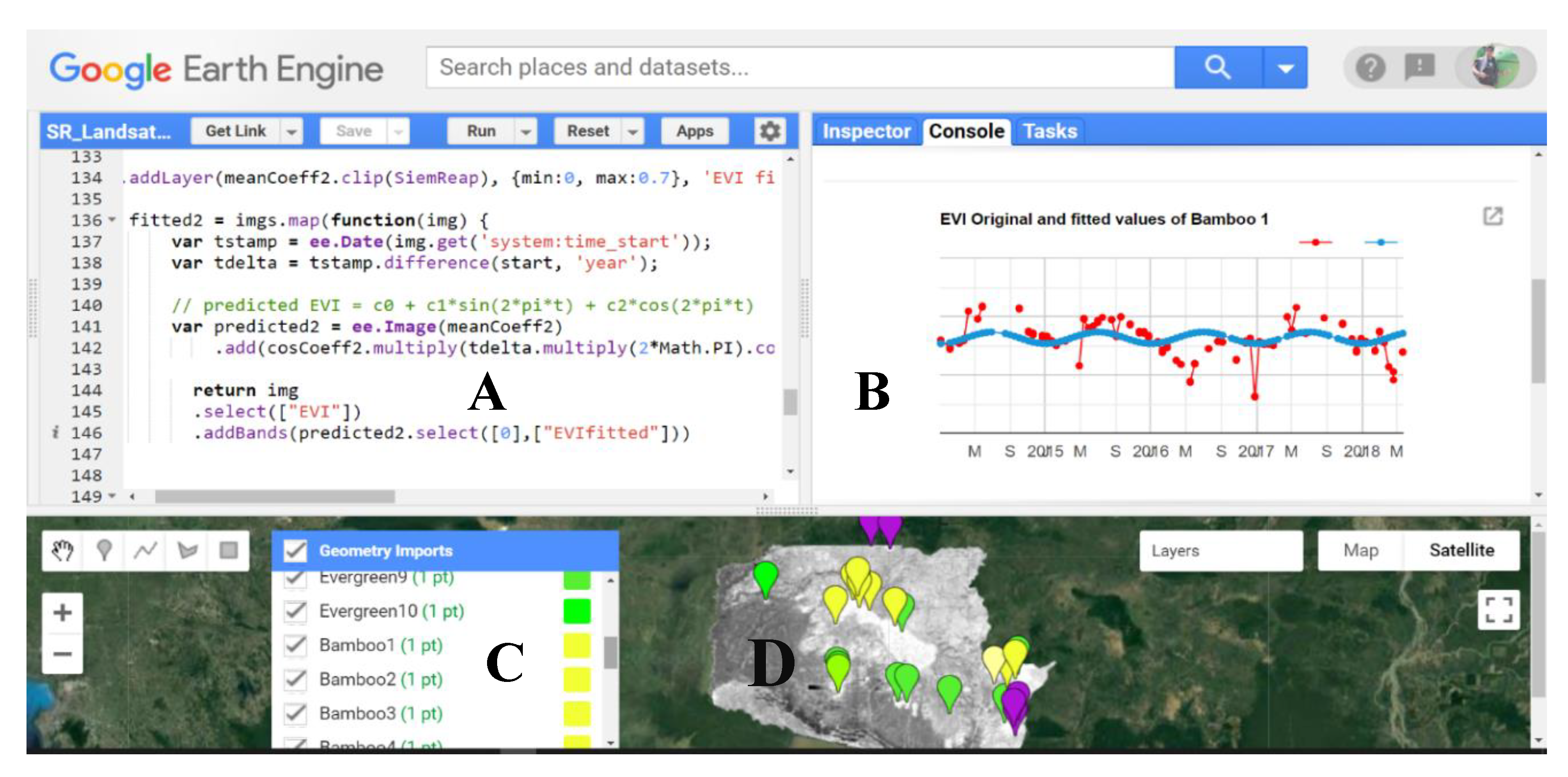
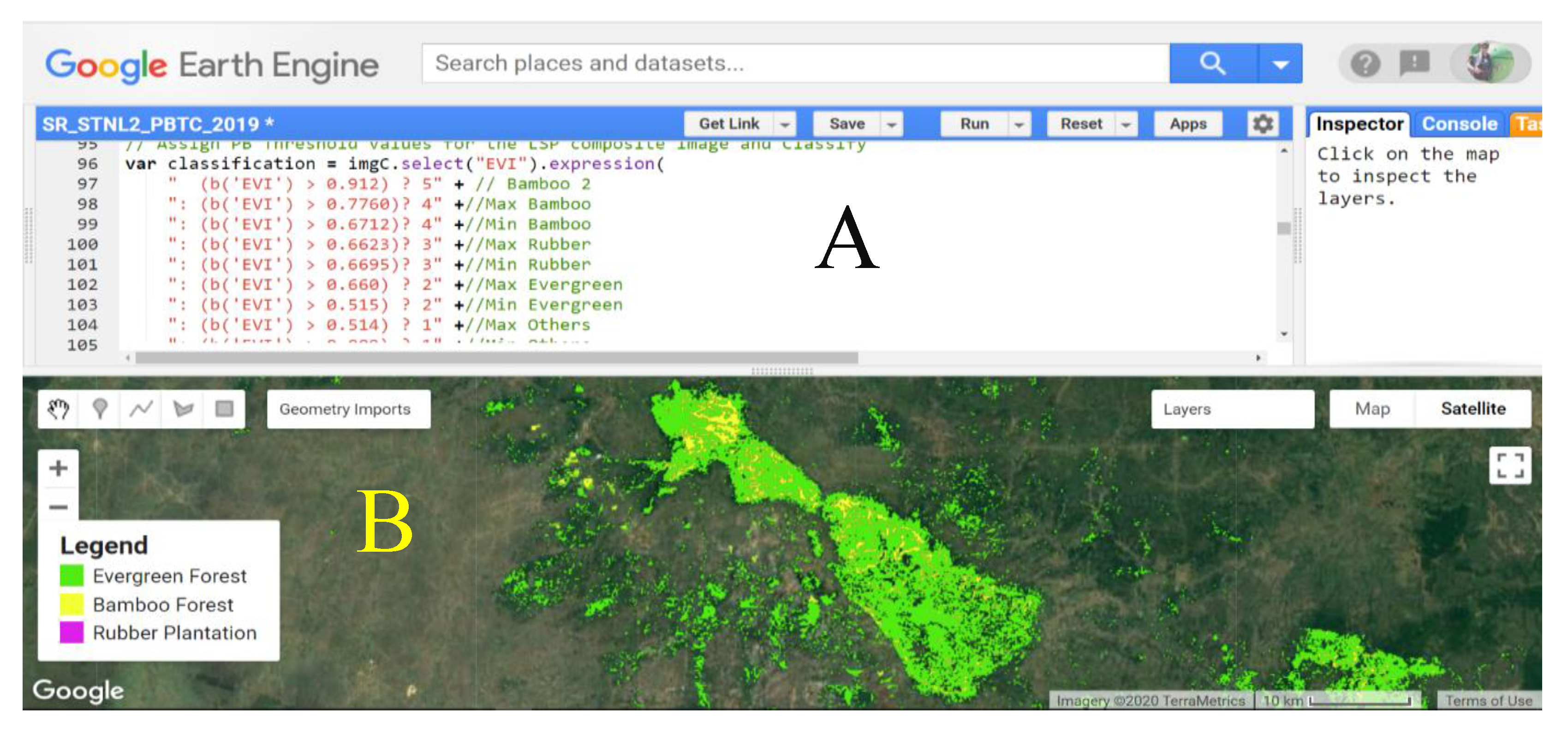
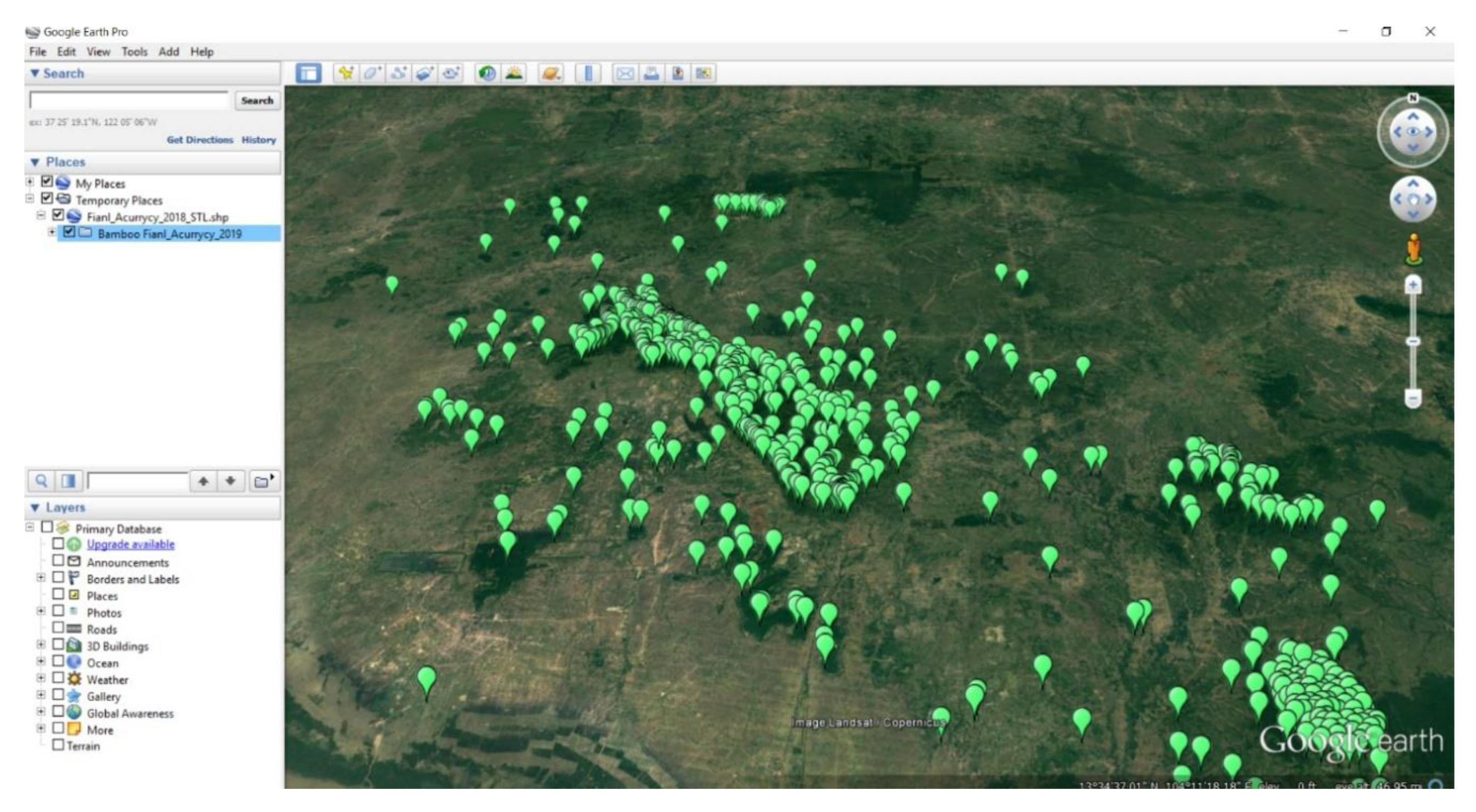

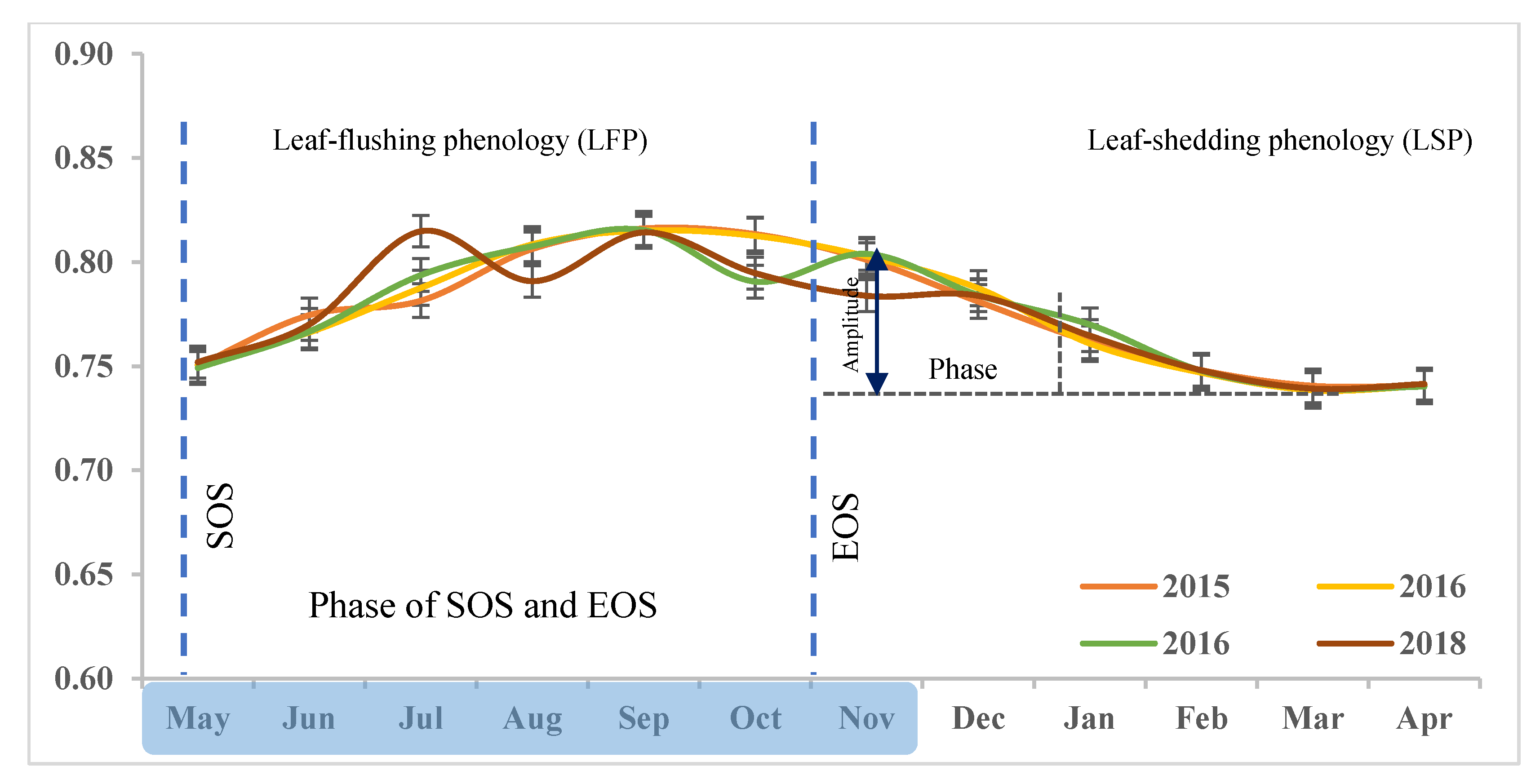
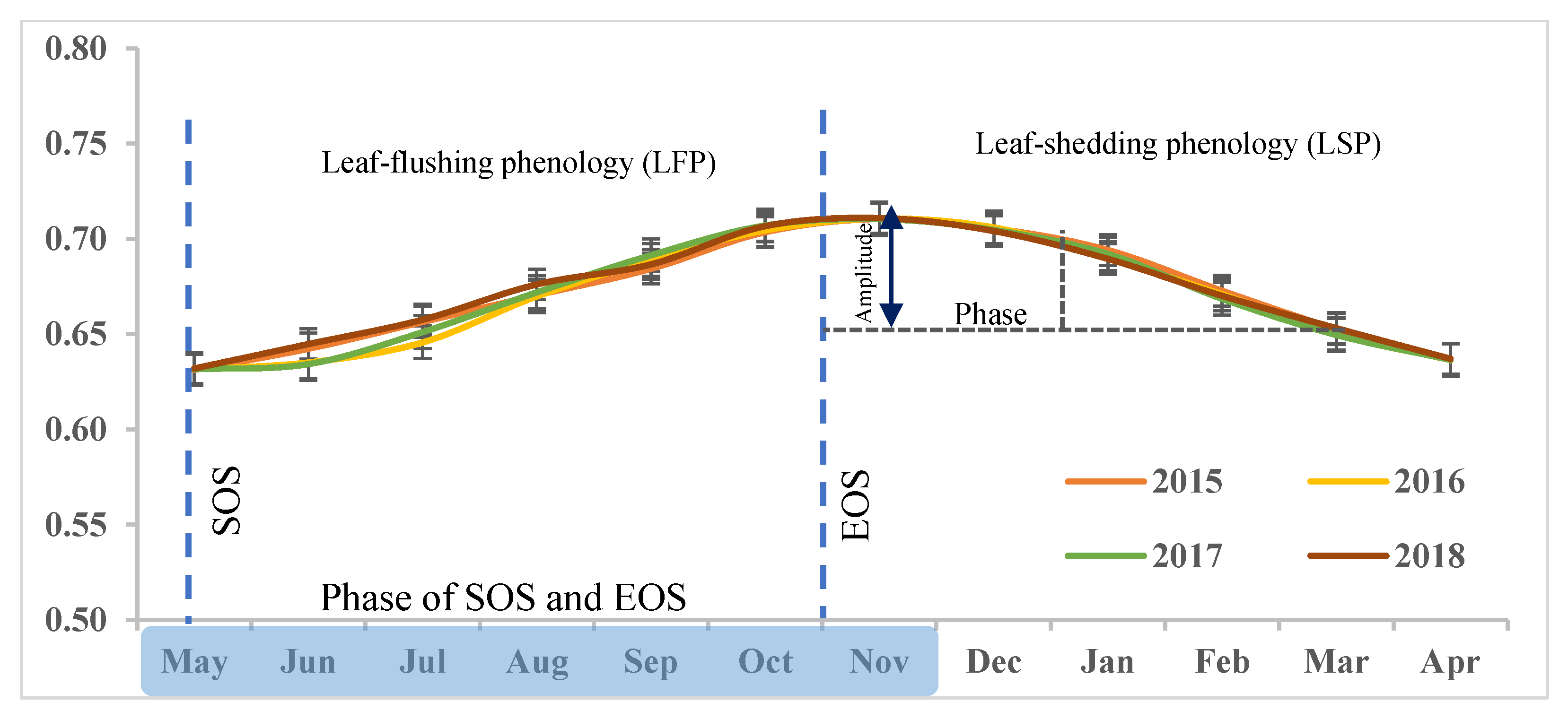

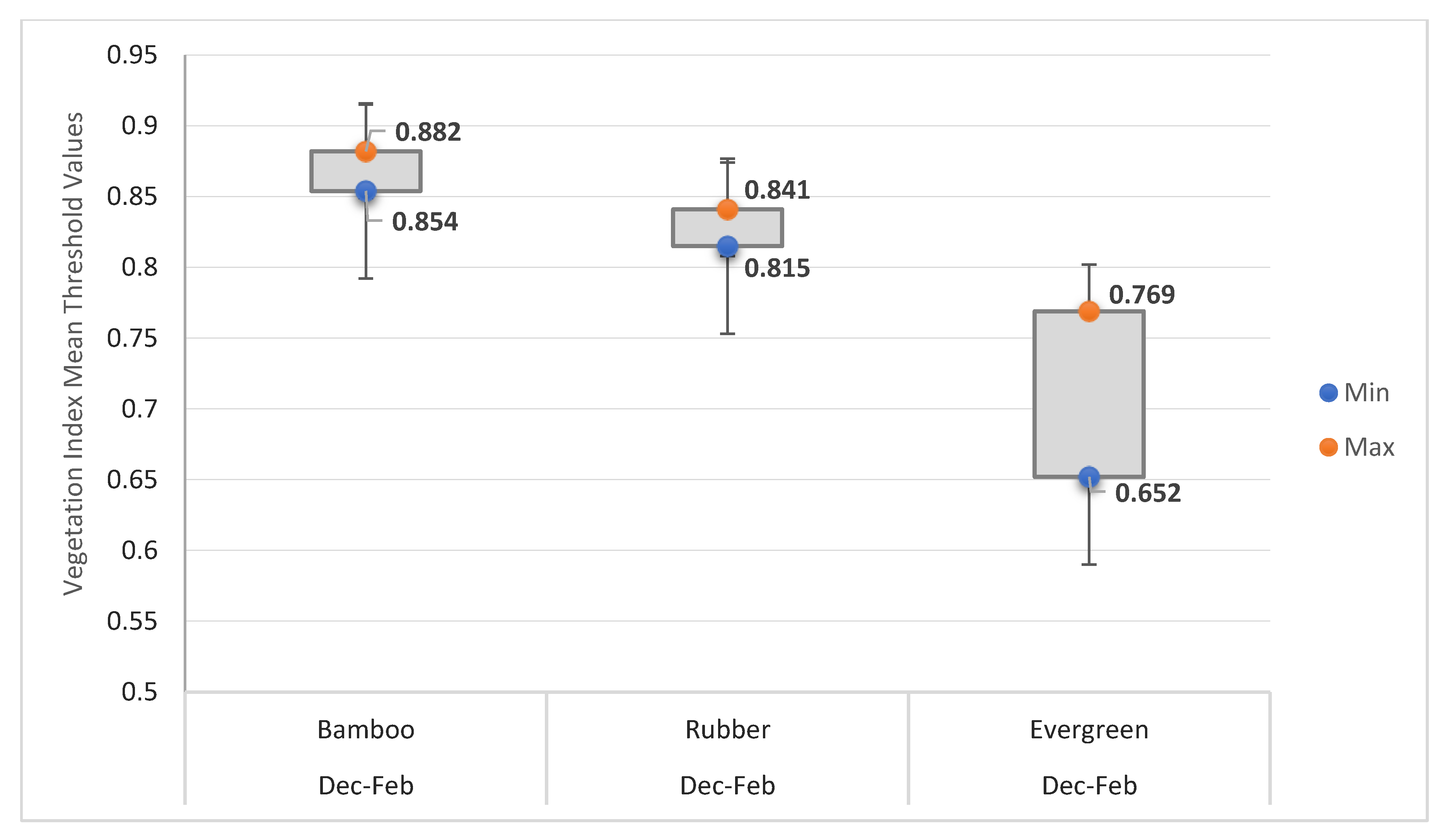
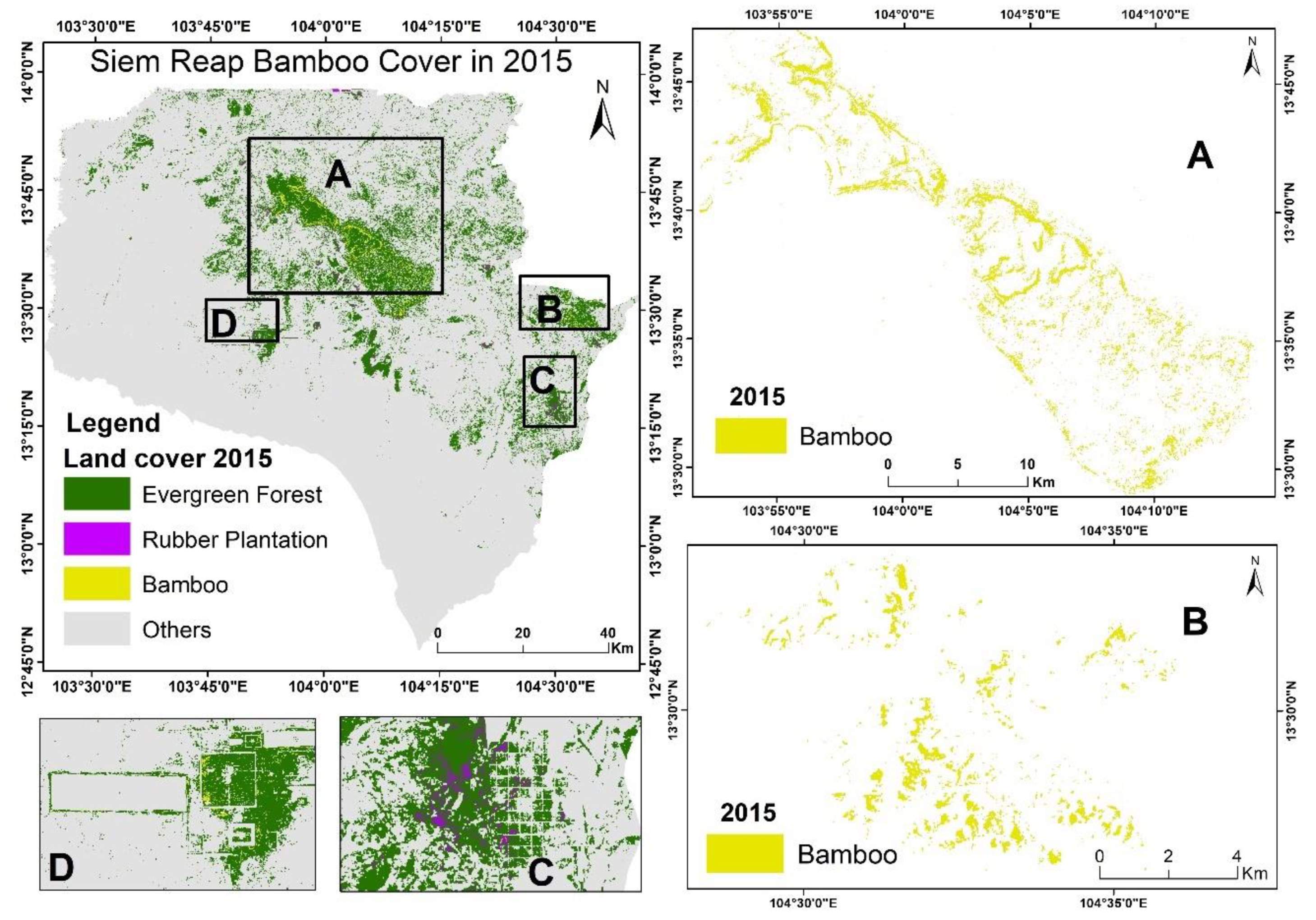

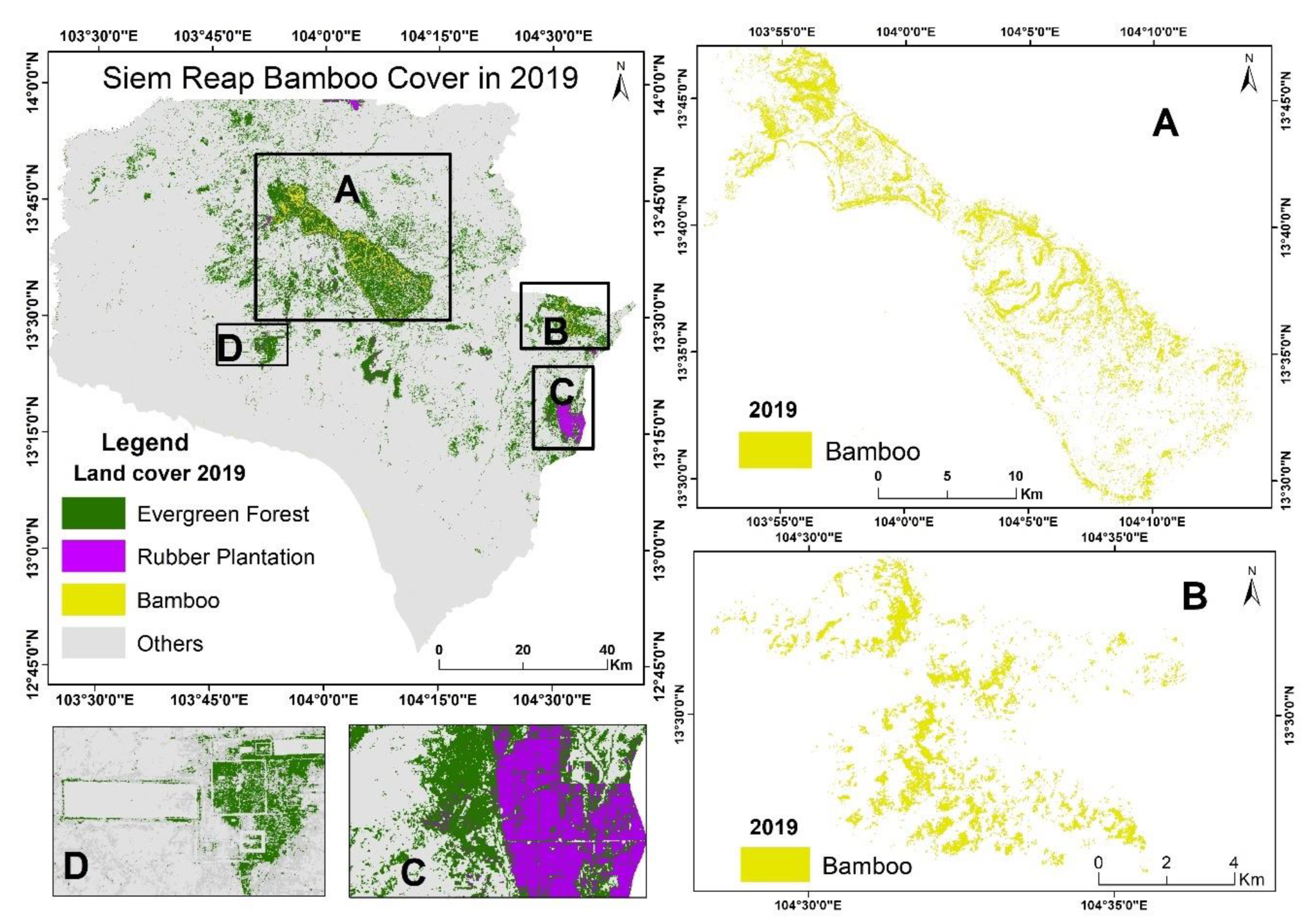


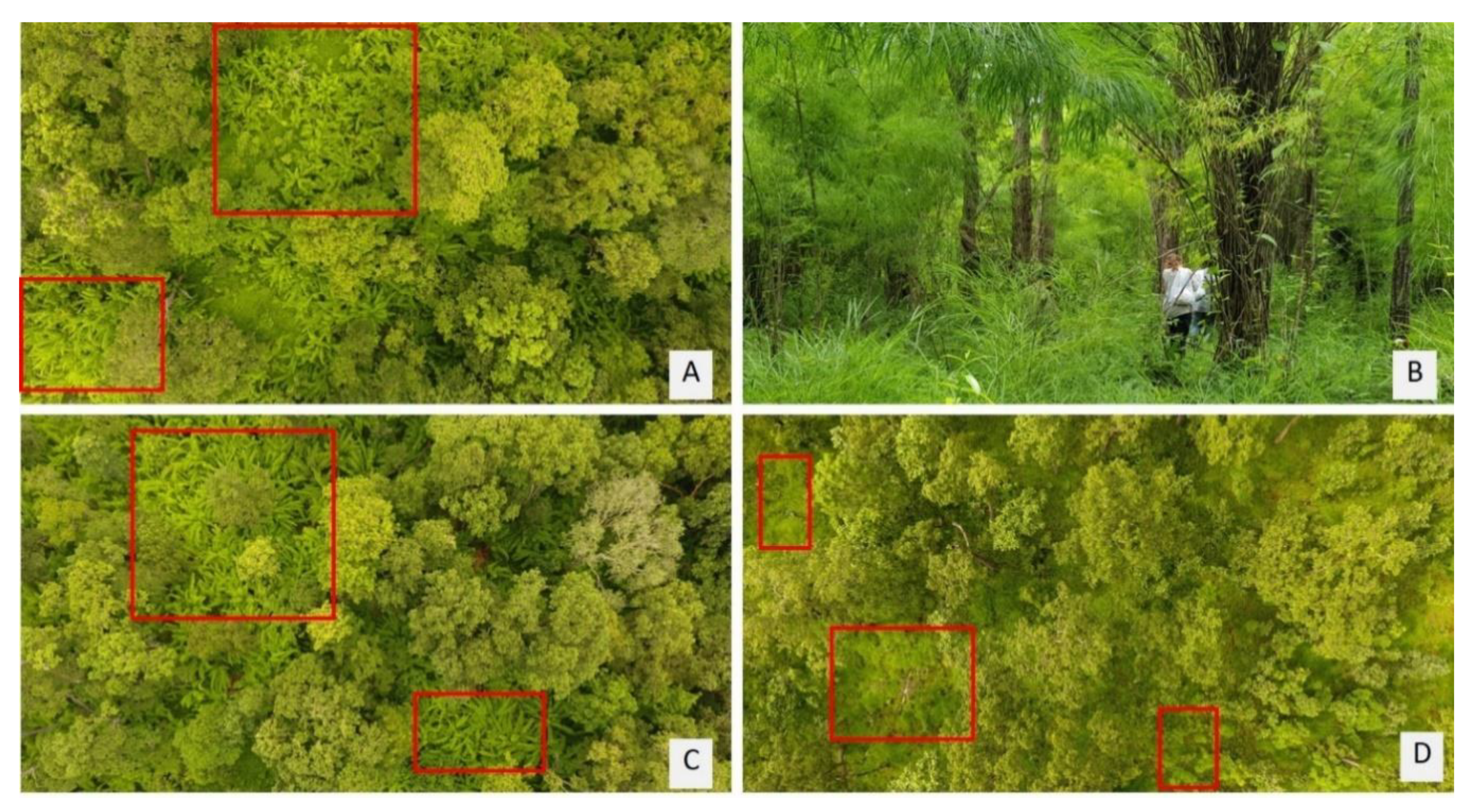
| Landsat 8 OLI | |||||
|---|---|---|---|---|---|
| PATH | ROW | 2015 | 2016 | 2017 | 2018 |
| 126 | 50 | 17 | 16 | 16 | 15 |
| 51 | 21 | 20 | 18 | 16 | |
| 127 | 50 | 20 | 20 | 19 | 18 |
| 51 | 17 | 22 | 22 | 20 | |
| Total Collections | 75 | 78 | 75 | 69 | |
| Cloud-Free Month and Year | PATH/ROW Sentinel-2 TILE | Landsat 8 Sentinel-2 | Number of Images/Tiles |
|---|---|---|---|
| December–February | 126/50 | L-8-OLI-TOA | 20 |
| 2014–2015 | 127/51 | ||
| December–February | 126/50 | L-8-OLI-TOA | 20 |
| 2017–2018 | 127/51 | ||
| January–December 2019 | 48PUA, 48PUV, 48PVA, 48PVV | Sentinel-2 | 442 |
| Total | 482 |
| Forest Category | Evergreen | Rubber | Bamboo | User’s Accuracy |
|---|---|---|---|---|
| Landsat OLI imagery in 2015 | ||||
| Evergreen | 268 | 5 | 7 | 95.70%> |
| Rubber | 17 | 88 | 3 | 81.50% |
| Bamboo | 33 | 1 | 220 | 86.60% |
| Producer’s accuracy | 84.30% | 93.60% | 95.70% | Overall Accuracy 89.72% |
| Kappa 0.83 | ||||
| Landsat OLI imagery in 2018 | ||||
| Evergreen | 286 | 29 | 4 | 89.70% |
| Rubber | 2 | 64 | 1 | 95.50% |
| Bamboo | 30 | 1 | 225 | 87.90% |
| Producer’s accuracy | 89.90% | 68.10% | 97.80% | Overall Accuracy 89.56% |
| Kappa 0.82 | ||||
| Sentinel-2 imagery for 2019 | ||||
| Evergreen | 273 | 11 | 14 | 91.60% |
| Rubber | 7 | 88 | 5 | 88.00% |
| Bamboo | 28 | 5 | 211 | 86.50% |
| Producer’s Accuracy | 88.60% | 84.60% | 91.70% | Overall Accuracy 89.10% |
| Kappa 0.82 | ||||
| District Name | 2015 | 2018 | 2019 | |||
|---|---|---|---|---|---|---|
| Area (ha) | (Mg C) | Area (ha) | (Mg C) | Area (ha) | (Mg C) | |
| Angkor Chum | 26 | 1504 | 20 | 1137 | 20 | 1142 |
| Angkor Thum | 36 | 2061 | 18 | 1039 | 55 | 3134 |
| Banteay Srei | 826 | 47,395 | 862 | 49,479 | 831 | 47,682 |
| Chi Kraeng | 270 | 15,521 | 253 | 14,522 | 215 | 12,335 |
| Kralanh | 2 | 121 | 2 | 126 | 3 | 189 |
| Puok | 3 | 149 | 1 | 75 | 1 | 69 |
| Prasat Bakong | 3 | 178 | 3 | 189 | 5 | 258 |
| Krong Siem Reab | 20 | 1165 | 22 | 1246 | 30 | 1693 |
| Soutr Nikom | 14 | 798 | 8 | 448 | 53 | 3054 |
| Srei Snam | 11 | 603 | 2 | 86 | 1 | 63 |
| Svay Leu | 757 | 43,469 | 787 | 45,145 | 734 | 42,132 |
| Varin | 706 | 40,547 | 733 | 42,091 | 725 | 41,615 |
| Total | 2674 | 153,511 | 2711 | 155,583 | 2672 | 153,367 |
| Bamboo Emissions (Mg CO2) | 562,872 | 570,470 | 562,346 | |||
| Carbon Emissions by tourists visiting Siem Reap (Mg CO2) | 8,693,652 | 9,107,635 | ||||
| Carbon Offsetting Rate (from Tourists-Based Emissions) | 6.5% | 6.3% | ||||
© 2020 by the authors. Licensee MDPI, Basel, Switzerland. This article is an open access article distributed under the terms and conditions of the Creative Commons Attribution (CC BY) license (http://creativecommons.org/licenses/by/4.0/).
Share and Cite
Venkatappa, M.; Anantsuksomsri, S.; Castillo, J.A.; Smith, B.; Sasaki, N. Mapping the Natural Distribution of Bamboo and Related Carbon Stocks in the Tropics Using Google Earth Engine, Phenological Behavior, Landsat 8, and Sentinel-2. Remote Sens. 2020, 12, 3109. https://doi.org/10.3390/rs12183109
Venkatappa M, Anantsuksomsri S, Castillo JA, Smith B, Sasaki N. Mapping the Natural Distribution of Bamboo and Related Carbon Stocks in the Tropics Using Google Earth Engine, Phenological Behavior, Landsat 8, and Sentinel-2. Remote Sensing. 2020; 12(18):3109. https://doi.org/10.3390/rs12183109
Chicago/Turabian StyleVenkatappa, Manjunatha, Sutee Anantsuksomsri, Jose Alan Castillo, Benjamin Smith, and Nophea Sasaki. 2020. "Mapping the Natural Distribution of Bamboo and Related Carbon Stocks in the Tropics Using Google Earth Engine, Phenological Behavior, Landsat 8, and Sentinel-2" Remote Sensing 12, no. 18: 3109. https://doi.org/10.3390/rs12183109
APA StyleVenkatappa, M., Anantsuksomsri, S., Castillo, J. A., Smith, B., & Sasaki, N. (2020). Mapping the Natural Distribution of Bamboo and Related Carbon Stocks in the Tropics Using Google Earth Engine, Phenological Behavior, Landsat 8, and Sentinel-2. Remote Sensing, 12(18), 3109. https://doi.org/10.3390/rs12183109







